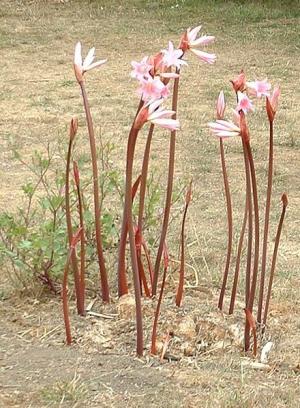Amaryllis Is Poisonous To Pets

Amaryllis is a small genus of flowering bulbs consisting of two of two species: Amaryllis belladonna L. and Amaryllis paradisicola. A member of the liliaceae, or lily family, amaryllis belongs to one of the most familiar and economically important families; a family made up of more than 280 genera and some 4200 species that include the common ornamentals: lilies, tulips, hyacinths, and daffodils; as well as the food plants: asparagus, garlic, onions, leeks, shallots, and chives. With such a variety of plants within its ranks, the liliaceae include a number of toxic (some quite deadly) species of plant as well.
Plants of the genus Amaryllis are known by a variety of names to include belladonna lily, Jersey lily, naked lady, amarillo or, in South Africa, March lily. The name Amaryllis is taken from a shepherdess in Virgil's pastoral Eclogues, from the Greek amarysso, meaning "to sparkle"; whereas belladonna means beautiful lady. The appearance of the tall, flower stalk without any leaves is believed to account for the common name "naked lady".
Originally indigenous to the South Western Cape of South Africa with small distributions in Andiean South America, the plant is now widely cultivated as an both an indoor and outdoor ornamental throughout the world. In the United States, amaryllis has gradually become naturalized from plantings in urban and suburban areas and can now be found throughout the lower elevations and coastal areas along much of the West Coast; environments that mimic their native South African habitat.
Amaryllis should be considered toxic as the plant contains a variety of toxic alkaloids; the most prevalent being lycorine. Others alkaloids in amaryllis include pancracine, vittatine, hydroxyvittatine, hippeastrine, and an as of yet unidentified new alkaloid. These latter alkaloids, however, occur in such small amounts as to make their toxic contribution negligible making lycorine the primary toxic principle of the plant. All parts of the plant should be considered toxic, with the bulb having the greatest concentration of toxins.
The exact lethality or danger posed by amaryllis ingestion is a matter of some debate; the medical literature contains no pet related case reports and only a few reports of human ingestion. Of the information that is available, the potential consequences of ingestion vary widely from one extreme to the other depending upon the source of the article; one source stating “ingesting any part of the plant can cause complete kidney failure and death in 36-72 hours” while another states that “eating the bulbs of amaryllis may cause nausea, salivation, diarrhea, and vomiting”.
Luckily, however, lycorine (the primary toxic principle of amaryllis) is a not uncommon plant toxin found in a variety of other plant species. As a result its effects on pets have been documented in case studies involving the ingestion of daffodils. What is apparent is that the effects of ingesting plants containing lycorine, are more severe in animals; especially cats, than humans. Depending upon the amount of toxin ingested the symptoms can vary from mild to severe and may include one or more of the following: vomiting (may be persistent), diarrhea, obvious abdominal pain, hyper salivation, anorexia, tremors, seizures, hypotension, and hypothermia; ingestion of larger amounts can cause paralysis, central nervous system collapse and death.
As is the case with any potentially toxic plant, it is imperative that the pet owner exercise caution and prevent animals from gaining access to areas where the plant either grows wildly or is intentionally cultivated for its ornamental value.
Treatment for the ingestion of plants containing lycorine is symptomatic and supportive; there is no specific treatment or antidote. If the ingestion was recent remove any existing plant matter from the mouth and flush the mouth thoroughly with water. Unless it is recognized very early on that a pet ingested a plant containing lycorine or the amounts involved are large, vomiting the patient is probably not recommended, as the emetic effects of the toxin will inevitably cause the patient to vomit spontaneously . When significant amounts are involved, and there is danger of prolonged vomiting or nongastrointestinal effects, lavage may be indicated. Although activated medical charcoal may be very useful in adsorbing these alkaloids, its use may be limited since symptoms of vomiting and diarrhea can take an hour or more to manifest from the time of ingestion. If the vomiting and diarrhea are extensive, patients should be monitored for fluid and electrolyte loss. In cases where animals have ingested a large amount, hypotension, seizures and hepatic damage have been reported; patients should have blood pressure and liver function monitored. Prevent further ingestion of the plant and consult your veterinarian.
Professional veterinary treatment is rarely necessary for ingestion of amaryllis. The emetic effect of the plant and its overall lack of palatability tend to dissuade animals from ingesting large amounts. In cases involving a small amount most pets will naturally make a full recovery in one to two days with at home symptomatic and supportive care. As with any plant or toxin that causes mild to severe diarrhea, dehydration can become an issue. Insure that your pet maintains and adequate intake of fluids.




